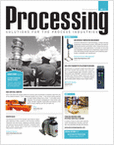Saturday, March 21, 2009
Display problem ? Click HERE
Recommended :
Subscribe FREE - Processing Magazine
 Previous post "Several Criteria and Constraints for Flare Network - Process" has discussed several major important criteria and constraints related flare system. In particular, back pressure is critical to performance of pressure relief valve (PRV) from capacity and stability aspect. Back pressure at PRV is typically back calculated from flare tip, main header, sub-header and finally tail pipe. Isothermal equation may be used for flare pipe pressure drop calculation for conservatism. AFSA or FLARENET is commonly used for flare network modeling. In calculating back pressure at the PRV, flare tip pressure drop is required. However, the pressure drop of flare is subject to Flare tip vendor design. How shall engineer determine the pressure drop of flare tip without vendor information especially during conceptual design ?
Previous post "Several Criteria and Constraints for Flare Network - Process" has discussed several major important criteria and constraints related flare system. In particular, back pressure is critical to performance of pressure relief valve (PRV) from capacity and stability aspect. Back pressure at PRV is typically back calculated from flare tip, main header, sub-header and finally tail pipe. Isothermal equation may be used for flare pipe pressure drop calculation for conservatism. AFSA or FLARENET is commonly used for flare network modeling. In calculating back pressure at the PRV, flare tip pressure drop is required. However, the pressure drop of flare is subject to Flare tip vendor design. How shall engineer determine the pressure drop of flare tip without vendor information especially during conceptual design ?Some simple clues for pressure drop estimation across a sonic flare tip and subsonic flare tip will be discussed. It may be used as first estimate and shall be used for detailed design. As flare tip pressure drop is subject to flare tip design, pressure drop provided by vendor shall always be used during detailed design.
For a sonic flare tip, pressure drop may be in the range of 3 - 5 bar. Pressure drop of upto to 7 bar has also been used. Flare system with sonic flare tip may experience high back pressure, high pressure (HP) system with high set pressure PRV may discharge into flare system with sonic tip.
For a subsonic flare tip, pressure drop is generally very small (possibly lower than 1 bar). Low pressure (LP) system PRV is generally discharge into flare system with subsonic flare tip as low back pressure is expected. Following is a typical flare tip pressure drop versus flow for different flare tip diameter.
Related Topic
- Several Criteria and Constraints for Flare Network - Process
- Several Criteria and Constraints for Flare Network - Piping
- Provide More than One Flare KOD in SERIES
- Elevated Flare (SI Unit) Datasheet
- ANSI/API Std 537 / ISO 25457 2nd edition, Dec 2008 is Released
- Flare Tip Quick Selection Chart
- Flare Smokeless Ringlemann Chart

0 Comments:
Post a Comment
Let us know your opinion !!! You can use some HTML tags, such as <b>, <i>, <a>
Subscribe to Post Comments [Atom]
Home:
<< Home